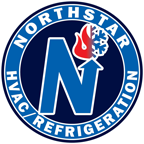Why Regular Leak Detection is Critical for Ammonia Systems
Written by Ed Rice
Ammonia (R-717) has long been a leading refrigerant in industrial refrigeration systems thanks to its high energy efficiency, zero global warming potential (GWP), and low cost. But as beneficial as ammonia is, it also comes with unique safety risks—most notably its toxicity and potential for serious harm if leaked.
Whether you operate a cold storage facility, food processing plant, or ice rink, routine ammonia leak detection isn’t optional—it’s essential for the health of your personnel, the integrity of your operation, and your regulatory compliance.
In this week's blog, we’ll explore why ammonia leak detection is critical, what the risks are, and how regular monitoring can protect your business.
The Risks of Ammonia Leaks
While ammonia is environmentally friendly, it is classified as a hazardous substance by OSHA and the EPA. Exposure to ammonia gas or liquid can lead to:
Eye, skin, and respiratory irritation
Chemical burns
Corrosive damage to equipment and infrastructure
Potential facility evacuations
Environmental contamination
In high concentrations, an uncontrolled ammonia release can be life-threatening, particularly in confined or poorly ventilated areas. This is why systems using more than 10,000 lbs. of ammonia fall under OSHA’s Process Safety Management (PSM) and the EPA’s Risk Management Plan (RMP) rules.
Why Routine Leak Detection Matters
1. Protecting Employee Health and Safety
Early detection of ammonia leaks ensures that minor leaks don’t escalate into serious health hazards. Fixed gas detection systems, portable monitors, and routine sensor testing can:
Alert staff to dangerous concentrations
Trigger ventilation or alarm systems automatically
Allow for immediate evacuation or containment
Reduce long-term exposure risks for operators and technicians
2. Maintaining Regulatory Compliance
Agencies like OSHA, the EPA, and local health departments require facilities using ammonia to:
Install and maintain detection and ventilation systems
Conduct regular inspections, testing, and calibration
Log leak events and mitigation responses
Develop and document emergency response plans
Failure to meet these requirements can result in fines, shutdowns, and liability in the event of an incident.
IIAR 2 and ASHRAE 15 also outline specific ammonia leak detection requirements, particularly for machinery rooms and enclosed spaces.
3. Preventing Equipment Damage and System Downtime
Ammonia leaks, even small ones, can lead to:
Corrosion of piping, valves, and electrical systems
Contaminated lubricants that degrade compressor performance
Reduced system efficiency and increased energy use
Costly downtime and emergency service calls
Regular leak detection protects your equipment investment and avoids interruptions during critical operations.
4. Environmental Protection
Because ammonia is water-soluble, any leak can contaminate storm drains, groundwater, or nearby ecosystems. Early detection and containment prevent:
Environmental harm
Costly cleanup
Negative press and community backlash
Best Practices for Ammonia Leak Detection
To ensure you're doing more than just checking a box, follow these best practices:
1. Install Fixed Leak Detection Systems
Place fixed sensors in:
Machinery rooms
Valved piping sections
Refrigerated rooms and occupied areas near equipment
Make sure sensors:
Are calibrated at regular intervals
Connect to audible and visual alarms
Interface with emergency exhaust and shutoff systems
2. Maintain Portable Gas Detectors
Equip maintenance and operations staff with calibrated portable detectors. These are critical during:
Service and repair work
Valve or seal inspections
Walkthroughs in less monitored areas
3. Log and Respond to Minor Leaks
Even if a leak doesn’t exceed the alarm threshold, it should be logged and investigated. Look for patterns or repeat issues in:
Welded joints
Valve stems
Compressor shaft seals
Gasketed flanges
4. Include Leak Detection in Preventative Maintenance
Leak checks should be part of every PM visit to inspect:
Sensor calibration and accuracy
Piping and valve assemblies
Oil and refrigerant levels
Warning system functionality
How Northstar Refrigeration Can Help
At Northstar Refrigeration, safety is built into everything we do. Our ammonia system specialists can help you:
Design and install code-compliant detection systems
Perform routine inspections and calibrations
Create custom PM programs with built-in leak checks
Prepare for audits or regulatory inspections
Train your staff on detection equipment and emergency protocols
Call us today at (508) 888-3692 to schedule a system check or compliance audit.
Final Thoughts
In ammonia refrigeration, what you don’t see can hurt you. Regular leak detection is about more than just staying compliant—it’s about protecting people, preserving equipment, and operating responsibly.
Don’t wait for an alarm to take action. Partner with Northstar Refrigeration and ensure your ammonia system runs safely, reliably, and efficiently all year long.
(508) 888-3692
www.northstarhvacr.com


